Page 306 of 351

6-56
Finish Damage
Any stone chips, fractures or deep scratches in the finish
should be repaired right away. Bare metal will corrode
quickly and may develop into a major repair expense.
Minor chips and scratches can be repaired with touch
-up
materials available from your dealer or other service
outlets. Larger areas of finish damage can be corrected
in your dealer's body and paint shop.
Underbody Maintenance
Chemicals used for ice and snow removal and dust
control can collect on the underbody. If these are not
removed, accelerated corrosion (rust) can occur on
the underbody parts such as fuel lines, frame, floor
pan and exhaust system even though they have
corrosion protection.At least every spring, flush these materials from the
underbody with plain water. Clean any areas where mud
and other debris can collect. Dirt packed in closed areas
of the frame should be loosened before being flushed.
Your dealer or an underbody car washing system can do
this for you.
Chemical Paint Spotting
Some weather and atmospheric conditions can create
a chemical fallout. Airborne pollutants can fall upon
and attack painted surfaces on your vehicle. This
damage can take two forms: blotchy, ringlet
-shaped
discolorations, and small irregular dark spots etched
into the paint surface.
Although no defect in the paint job causes this, Buick
will repair, at no charge to the owner, the surfaces of
new vehicles damaged by this fallout condition within
12 months or 12,000 miles (20 000 km) of purchase,
whichever occurs first.
Page 314 of 351

6-64
Replacement Bulbs
Exterior Lamps Bulb Number
Back
-up 1156
Center High
-Mounted Stop 3155
Front Parking/Turn Signal 4157NAK
Headlamp, High Beam 9005
Headlamp, Low Beam 9006
Stop/Tail/Turn Signal 3057
Tail (Applique) 194
Interior Lamps Bulb Number
Dome Lamp 9425542
For service information on these bulbs, contact your
dealer service department.
Capacities and Specifications
Automatic Transaxle
Pan Removal and Replacement 7.4 quarts (7.0 L). . .
After Complete Overhaul 10 quarts (9.5 L). . . . . . .
When draining/replacing converter, more fluid will
be needed.
Cooling System
Including Reservoir11.3 quarts (10.7 L) . . . . . . . .
Refrigerant,
Air ConditioningSee the refrigerant . . . . . . . . . . .
label under the hood.
Engine Crankcase
Oil and Filter Change 4.5 quarts (4.3 L). . . . . . . . .
Wheel Nut Torque100 lb
-ft (140 N´m) . . . . . . . . . .
Fuel Tank17 U.S. gallons (64 L) . . . . . . . . . . . . . . .
All capacities are approximate. When adding, be sure
to fill to the approximate level, as recommended in this
manual. See ªRecommended Fluids and Lubricantsº
in the Index.
Page 317 of 351
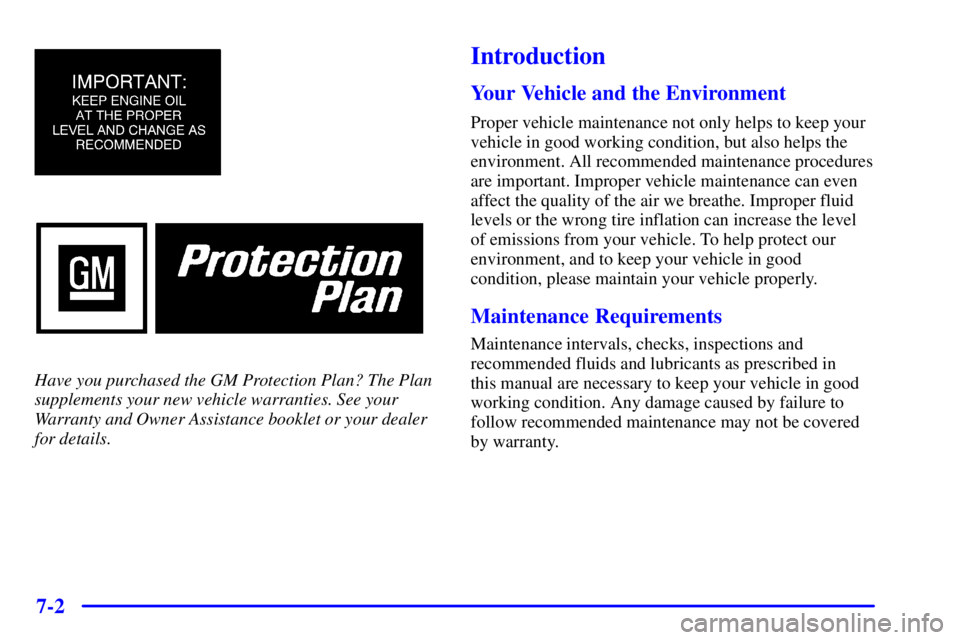
7-2
Have you purchased the GM Protection Plan? The Plan
supplements your new vehicle warranties. See your
Warranty and Owner Assistance booklet or your dealer
for details.
Introduction
Your Vehicle and the Environment
Proper vehicle maintenance not only helps to keep your
vehicle in good working condition, but also helps the
environment. All recommended maintenance procedures
are important. Improper vehicle maintenance can even
affect the quality of the air we breathe. Improper fluid
levels or the wrong tire inflation can increase the level
of emissions from your vehicle. To help protect our
environment, and to keep your vehicle in good
condition, please maintain your vehicle properly.
Maintenance Requirements
Maintenance intervals, checks, inspections and
recommended fluids and lubricants as prescribed in
this manual are necessary to keep your vehicle in good
working condition. Any damage caused by failure to
follow recommended maintenance may not be covered
by warranty.
Page 318 of 351
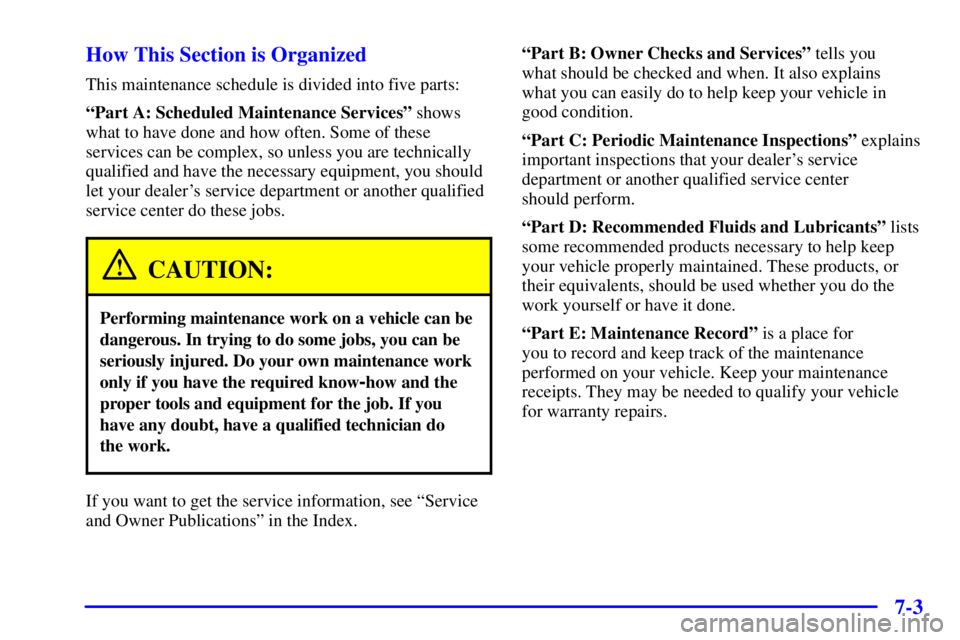
7-3 How This Section is Organized
This maintenance schedule is divided into five parts:
ªPart A: Scheduled Maintenance Servicesº shows
what to have done and how often. Some of these
services can be complex, so unless you are technically
qualified and have the necessary equipment, you should
let your dealer's service department or another qualified
service center do these jobs.
CAUTION:
Performing maintenance work on a vehicle can be
dangerous. In trying to do some jobs, you can be
seriously injured. Do your own maintenance work
only if you have the required know
-how and the
proper tools and equipment for the job. If you
have any doubt, have a qualified technician do
the work.
If you want to get the service information, see ªService
and Owner Publicationsº in the Index.ªPart B: Owner Checks and Servicesº tells you
what should be checked and when. It also explains
what you can easily do to help keep your vehicle in
good condition.
ªPart C: Periodic Maintenance Inspectionsº explains
important inspections that your dealer's service
department or another qualified service center
should perform.
ªPart D: Recommended Fluids and Lubricantsº lists
some recommended products necessary to help keep
your vehicle properly maintained. These products, or
their equivalents, should be used whether you do the
work yourself or have it done.
ªPart E: Maintenance Recordº is a place for
you to record and keep track of the maintenance
performed on your vehicle. Keep your maintenance
receipts. They may be needed to qualify your vehicle
for warranty repairs.
Page 319 of 351
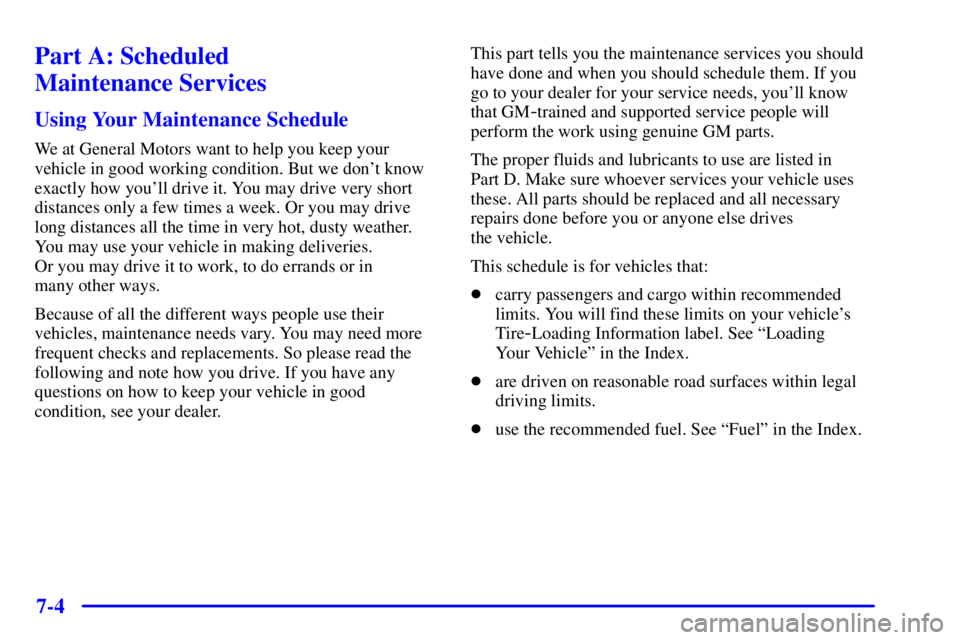
7-4
Part A: Scheduled
Maintenance Services
Using Your Maintenance Schedule
We at General Motors want to help you keep your
vehicle in good working condition. But we don't know
exactly how you'll drive it. You may drive very short
distances only a few times a week. Or you may drive
long distances all the time in very hot, dusty weather.
You may use your vehicle in making deliveries.
Or you may drive it to work, to do errands or in
many other ways.
Because of all the different ways people use their
vehicles, maintenance needs vary. You may need more
frequent checks and replacements. So please read the
following and note how you drive. If you have any
questions on how to keep your vehicle in good
condition, see your dealer.This part tells you the maintenance services you should
have done and when you should schedule them. If you
go to your dealer for your service needs, you'll know
that GM
-trained and supported service people will
perform the work using genuine GM parts.
The proper fluids and lubricants to use are listed in
Part D. Make sure whoever services your vehicle uses
these. All parts should be replaced and all necessary
repairs done before you or anyone else drives
the vehicle.
This schedule is for vehicles that:
�carry passengers and cargo within recommended
limits. You will find these limits on your vehicle's
Tire
-Loading Information label. See ªLoading
Your Vehicleº in the Index.
�are driven on reasonable road surfaces within legal
driving limits.
�use the recommended fuel. See ªFuelº in the Index.
Page 324 of 351
Scheduled Maintenance
7-9
7,500 Miles (12 500 km)
�Rotate tires. See ªTire Inspection and Rotationº in the Index for proper rotation
pattern and additional information. (See footnote @.) (See footnote +.)
15,000 Miles (25 000 km)
�Inspect engine air cleaner filter if you are driving in dusty conditions.
Replace filter if necessary.
An Emission Control Service. (See footnote �.)
�Replace passenger compartment air filter. If you drive regularly under dusty
conditions, the filter may require replacement more often.
�Rotate tires. See ªTire Inspection and Rotationº in the Index for proper rotation
pattern and additional information. (See footnote @.) (See footnote +.)
22,500 Miles (37 500 km)
�Rotate tires. See ªTire Inspection and Rotationº in the Index for proper rotation
pattern and additional information. (See footnote @.) (See footnote +.)
ACTUAL
SERVICED BY:MILEAGE
DATE
ACTUAL
SERVICED BY:MILEAGE
DATE
ACTUAL
SERVICED BY:MILEAGE
DATE
Page 325 of 351
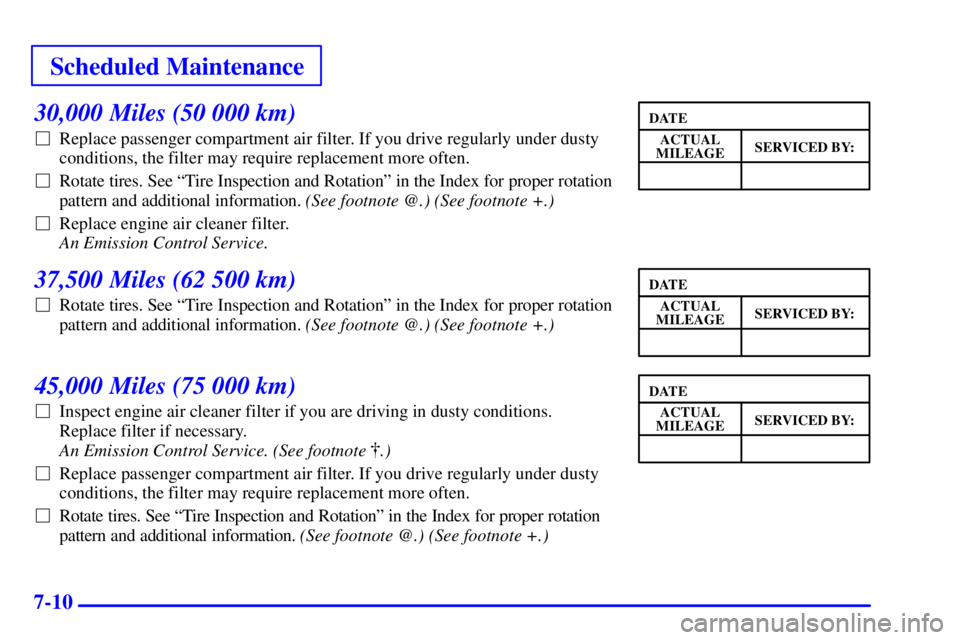
Scheduled Maintenance
7-10
30,000 Miles (50 000 km)
�Replace passenger compartment air filter. If you drive regularly under dusty
conditions, the filter may require replacement more often.
�Rotate tires. See ªTire Inspection and Rotationº in the Index for proper rotation
pattern and additional information. (See footnote @.) (See footnote +.)
�Replace engine air cleaner filter.
An Emission Control Service.
37,500 Miles (62 500 km)
�Rotate tires. See ªTire Inspection and Rotationº in the Index for proper rotation
pattern and additional information. (See footnote @.) (See footnote +.)
45,000 Miles (75 000 km)
�Inspect engine air cleaner filter if you are driving in dusty conditions.
Replace filter if necessary.
An Emission Control Service. (See footnote �.)
�Replace passenger compartment air filter. If you drive regularly under dusty
conditions, the filter may require replacement more often.
�Rotate tires. See ªTire Inspection and Rotationº in the Index for proper rotation
pattern and additional information. (See footnote @.) (See footnote +.)
ACTUAL
SERVICED BY:MILEAGE
DATE
ACTUAL
SERVICED BY:MILEAGE
DATE
ACTUAL
SERVICED BY:MILEAGE
DATE
Page 327 of 351
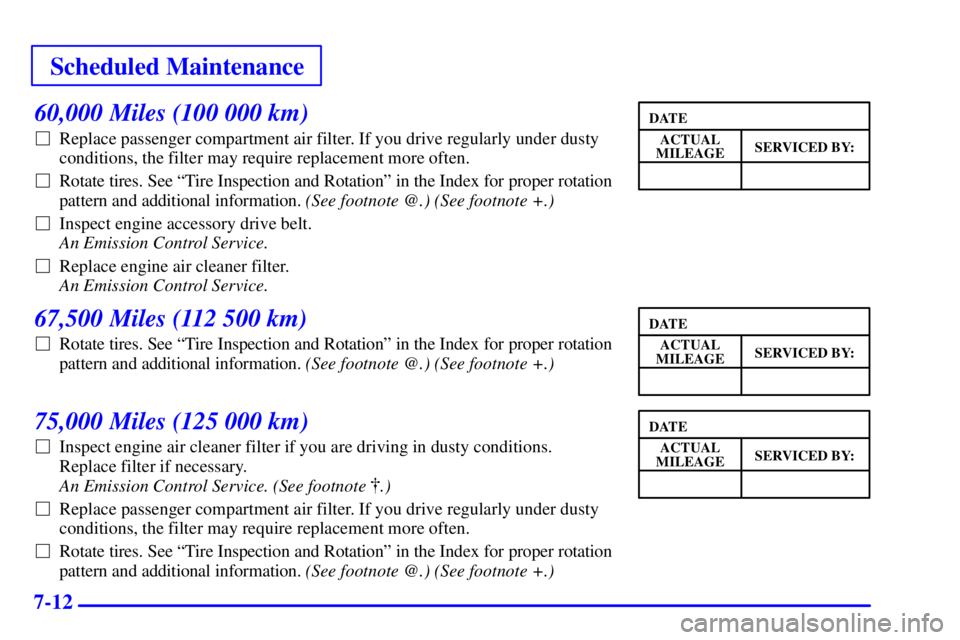
Scheduled Maintenance
7-12
60,000 Miles (100 000 km)
�Replace passenger compartment air filter. If you drive regularly under dusty
conditions, the filter may require replacement more often.
�Rotate tires. See ªTire Inspection and Rotationº in the Index for proper rotation
pattern and additional information. (See footnote @.) (See footnote +.)
�Inspect engine accessory drive belt.
An Emission Control Service.
�Replace engine air cleaner filter.
An Emission Control Service.
67,500 Miles (112 500 km)
�Rotate tires. See ªTire Inspection and Rotationº in the Index for proper rotation
pattern and additional information. (See footnote @.) (See footnote +.)
75,000 Miles (125 000 km)
�Inspect engine air cleaner filter if you are driving in dusty conditions.
Replace filter if necessary.
An Emission Control Service. (See footnote �.)
�Replace passenger compartment air filter. If you drive regularly under dusty
conditions, the filter may require replacement more often.
�Rotate tires. See ªTire Inspection and Rotationº in the Index for proper rotation
pattern and additional information. (See footnote @.) (See footnote +.)
ACTUAL
SERVICED BY:MILEAGE
DATE
ACTUAL
SERVICED BY:MILEAGE
DATE
ACTUAL
SERVICED BY:MILEAGE
DATE